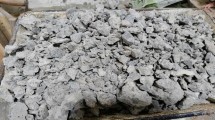Abstract
By means of reducing the ratio of water to cement (w/c), incorporating a proper amount of fly ash and superplasticizer, and processing the surface of recycled aggregate (RA), this paper aims at improving the interfacial transition zone (ITZ) submicro-structure of the regenerated concrete (RC). The experimental results of mercury intrusion pressure (MIP) show that RA pretreated by PVA polymer solution and lyophobic active agent can jam its surface pore and hole, thus the porosity of RA is decreased. When reducing w/c ratio, incorporating 20% of fly ash (FA) and 2.5% of superplasticizer (to cement) in the RC, the width of ITZ is effectively narrowed, the structure of ITZ is combined much more compact and the compressive strength of RC is enhanced. Under the same conditions, using RA pretreated by 1% PVA polymer solution, the fluidity of fresh RC can be enhanced and the compressive strength of hardened RC can also be enhanced lightly. Whereas using RA pretreated by lyophobic active agent, the fluidity of fresh RC can be enhanced, but it impairs the adhesion of fresh cement paste and the surface of old concrete, and hinders the strength development of RC. In the ITZ structure of ordinary concrete (prepared with natural coarse and fine aggregate) there are much Ca(OH)2, in plank-and sheet-like, distributing with priority tropism, whereas in the RC structure, Ca(OH)2 with a coarse size is not found in ITZ; the main reason is that the surface of coarse aggregate does not have a layer of water film.
Similar content being viewed by others
References
Limbachiya M C, Leelawat T, Dhir R K. Use of Recycled Concrete Aggregate in High-strength Concrete[J].Materials and Structures, 2000,33:574–580
Topcu I B, Guncan N F. Using Waste Concrete as Aggregate [J].Cem. Concr. Res., 1995,25(7):1385–1390
Yamasaki Jujji, Tatemastsu, Kazuhiko. Strength and Freezethaw Resistance Properties of Concrete Using High-quality Recycled Aggregate[J].Transactions of the Japan Concrete Institute, 1998,20:45–52
Poon C S, Shui Z H,et al. Influence of Moisture State of Natural and Recycled Aggregates on the Slump and Compressive Strength of Concrete[J].Cem. Concr. Res., 2004,34 (1):31–36
Dhir Ravindra, Paine Kevin, Dyer Tom. Recycling Construction and Demolition Wastes in Concrete[J].Concrete (London), 2004,38(3):25–28
Sidney Diamond. Consideration in Image Analysis as Applied to Investigations of the ITZ in Concrete[J].Cement and Concrete Composites, 2001,23:171–178
Sidney Diamond, Huang Jingdong. The ITZ in Concrete-a Different View Based on Image Analysis and SEM Abservations[J].Cement and Concrete Composites, 2001,23(2): 179–188
Scrivener K L, Crumbie A K, Pratt P L. A Study of the Interfacial Region between Cement Paste and Aggregate in Concrete[J].Materials Res. Soc. Proc., 1988,114:87–88
Tasong W A, Lynsdale C J. Aggregate-cement Paste Interface, Part I: Influence of Aggregate Geochemistry[J].Cem. Concr. Res., 1999,29(7):1019–1025
Aligizaki K K, Rooij M R. Analysis of Iron Oxides Accumulating at the Interface between Aggregate and Cement Paste [J].Cem. Concr. Res., 2000,30(12):1941–1945
Shui Zhonghe, Wan Huiwen. Distributions of Chemical Elements in Aggregate-Cement Interfacial Transition Zone in Old Concrete[J].Journal of Wuhan University of Technology, 2002,24(5):22–25
Poon C S, Shui Z H, Lam L. Effect of Microstructure of ITZ on Compressive Strength of Concrete Prepared with Recycled Aggregates[J].Construction and Building Materials, 2004, 18(6):461–468
Wu Zhongwei, Lian Huizhen.High Performance Concrete [M]. Beijing: Railway Press of China, 1999
Author information
Authors and Affiliations
Corresponding author
Additional information
Funded by Hubei Province Natural Science Fundation (2005ABA013).
Rights and permissions
About this article
Cite this article
Huiwen, W., Liyuan, Y. & Zhonghe, S. Modificatin of ITZ structure and properties of regenerated concrete. J. Wuhan Univ. Technol.-Mat. Sci. Edit. 21, 128–132 (2006). https://doi.org/10.1007/BF02840858
Received:
Accepted:
Issue Date:
DOI: https://doi.org/10.1007/BF02840858




